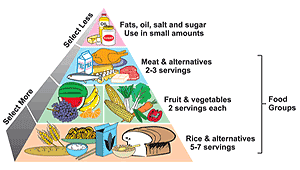What constitutes a single serving? This riddle has gotten trickier than ever, especially since fast food restaurants started super-sizing their meals. Ignorance about serving sizes undoubtedly plays a part in the growing obesity epidemic worldwide, and unless we are knowledgeable and careful about how much to eat, the problem is unlikely to go away. Here's how to determine the right portion size.
Recommended Daily Servings
Based on the Healthy Diet Pyramid, each of the four basic food groups should be consumed according to the recommended servings everyday for a balanced diet. In general, foods eaten should come most from the base (rice & grains) and least from the tip (fats) of the Pyramid.
 How many servings to eat a day?
How many servings to eat a day?
- Rice & Grains: 5-7 servings
- Fruits & Vegetables: 2 servings each
- Meat & Alternatives: 2-3 servings
- Fats, Oils, Salt & Sugar: In moderation
Read the nutrition facts on food labels
Packaged foods are the easiest to determine their serving size. Most of the time, they come with nutritional information printed on their labels. You can measure the amount of a single serving by looking at the 'Serving Size' indicated. For example, if your pack of cereals states that one serving equals a cup, you can pour the cereals into an empty cup to measure out a single serving.
 How many servings to eat a day?
How many servings to eat a day?






